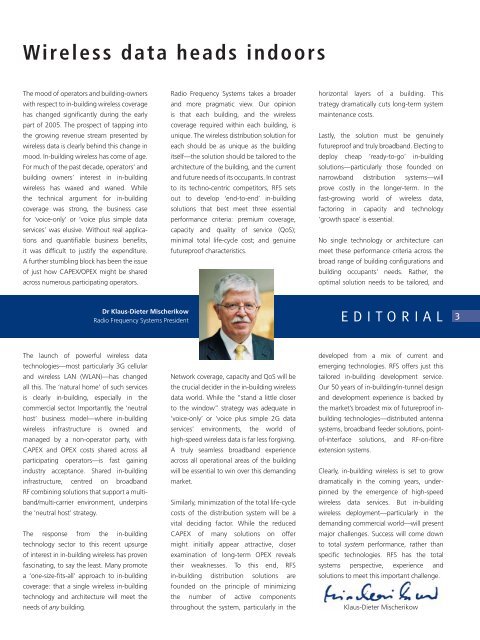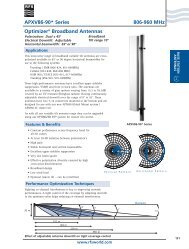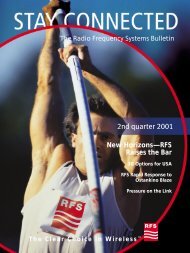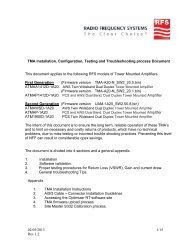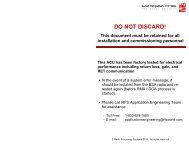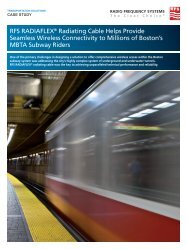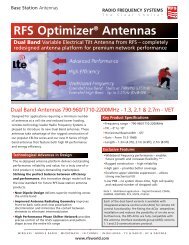download - Radio Frequency Systems
download - Radio Frequency Systems
download - Radio Frequency Systems
You also want an ePaper? Increase the reach of your titles
YUMPU automatically turns print PDFs into web optimized ePapers that Google loves.
Wireless data heads indoors<br />
The mood of operators and building-owners<br />
with respect to in-building wireless coverage<br />
has changed significantly during the early<br />
part of 2005. The prospect of tapping into<br />
the growing revenue stream presented by<br />
wireless data is clearly behind this change in<br />
mood. In-building wireless has come of age.<br />
For much of the past decade, operators’ and<br />
building owners’ interest in in-building<br />
wireless has waxed and waned. While<br />
the technical argument for in-building<br />
coverage was strong, the business case<br />
for ‘voice-only’ or ‘voice plus simple data<br />
services’ was elusive. Without real applications<br />
and quantifiable business benefits,<br />
it was difficult to justify the expenditure.<br />
A further stumbling block has been the issue<br />
of just how CAPEX/OPEX might be shared<br />
across numerous participating operators.<br />
<strong>Radio</strong> <strong>Frequency</strong> <strong>Systems</strong> takes a broader<br />
and more pragmatic view. Our opinion<br />
is that each building, and the wireless<br />
coverage required within each building, is<br />
unique. The wireless distribution solution for<br />
each should be as unique as the building<br />
itself—the solution should be tailored to the<br />
architecture of the building, and the current<br />
and future needs of its occupants. In contrast<br />
to its techno-centric competitors, RFS sets<br />
out to develop ‘end-to-end’ in-building<br />
solutions that best meet three essential<br />
performance criteria: premium coverage,<br />
capacity and quality of service (QoS);<br />
minimal total life-cycle cost; and genuine<br />
futureproof characteristics.<br />
horizontal layers of a building. This<br />
trategy dramatically cuts long-term system<br />
maintenance costs.<br />
Lastly, the solution must be genuinely<br />
futureproof and truly broadband. Electing to<br />
deploy cheap ‘ready-to-go’ in-building<br />
solutions—particularly those founded on<br />
narrowband distribution systems—will<br />
prove costly in the longer-term. In the<br />
fast-growing world of wireless data,<br />
factoring in capacity and technology<br />
‘growth space’ is essential.<br />
No single technology or architecture can<br />
meet these performance criteria across the<br />
broad range of building configurations and<br />
building occupants’ needs. Rather, the<br />
optimal solution needs to be tailored, and<br />
Dr Klaus-Dieter Mischerikow<br />
<strong>Radio</strong> <strong>Frequency</strong> <strong>Systems</strong> President<br />
EDITORIAL<br />
3<br />
The launch of powerful wireless data<br />
technologies—most particularly 3G cellular<br />
and wireless LAN (WLAN)—has changed<br />
all this. The ‘natural home’ of such services<br />
is clearly in-building, especially in the<br />
commercial sector. Importantly, the ‘neutral<br />
host’ business model—where in-building<br />
wireless infrastructure is owned and<br />
managed by a non-operator party, with<br />
CAPEX and OPEX costs shared across all<br />
participating operators—is fast gaining<br />
industry acceptance. Shared in-building<br />
infrastructure, centred on broadband<br />
RF combining solutions that support a multiband/multi-carrier<br />
environment, underpins<br />
the ‘neutral host’ strategy.<br />
The response from the in-building<br />
technology sector to this recent upsurge<br />
of interest in in-building wireless has proven<br />
fascinating, to say the least. Many promote<br />
a ‘one-size-fits-all’ approach to in-building<br />
coverage: that a single wireless in-building<br />
technology and architecture will meet the<br />
needs of any building.<br />
Network coverage, capacity and QoS will be<br />
the crucial decider in the in-building wireless<br />
data world. While the “stand a little closer<br />
to the window” strategy was adequate in<br />
‘voice-only’ or ‘voice plus simple 2G data<br />
services’ environments, the world of<br />
high-speed wireless data is far less forgiving.<br />
A truly seamless broadband experience<br />
across all operational areas of the building<br />
will be essential to win over this demanding<br />
market.<br />
Similarly, minimization of the total life-cycle<br />
costs of the distribution system will be a<br />
vital deciding factor. While the reduced<br />
CAPEX of many solutions on offer<br />
might initially appear attractive, closer<br />
examination of long-term OPEX reveals<br />
their weaknesses. To this end, RFS<br />
in-building distribution solutions are<br />
founded on the principle of minimizing<br />
the number of active components<br />
throughout the system, particularly in the<br />
developed from a mix of current and<br />
emerging technologies. RFS offers just this<br />
tailored in-building development service.<br />
Our 50 years of in-building/in-tunnel design<br />
and development experience is backed by<br />
the market’s broadest mix of futureproof inbuilding<br />
technologies—distributed antenna<br />
systems, broadband feeder solutions, pointof-interface<br />
solutions, and RF-on-fibre<br />
extension systems.<br />
Clearly, in-building wireless is set to grow<br />
dramatically in the coming years, underpinned<br />
by the emergence of high-speed<br />
wireless data services. But in-building<br />
wireless deployment—particularly in the<br />
demanding commercial world—will present<br />
major challenges. Success will come down<br />
to total system performance, rather than<br />
specific technologies. RFS has the total<br />
systems perspective, experience and<br />
solutions to meet this important challenge.<br />
Klaus-Dieter Mischerikow


